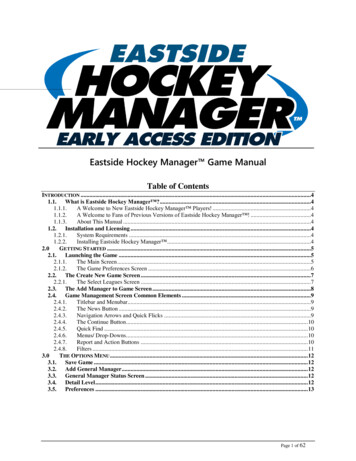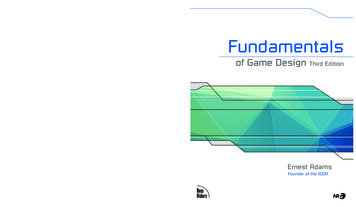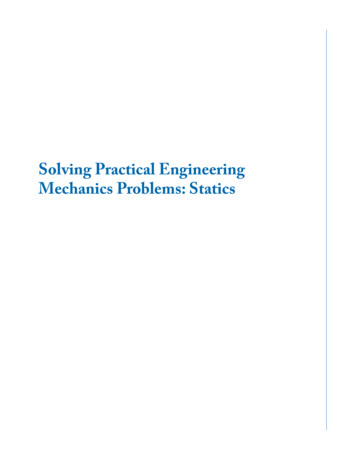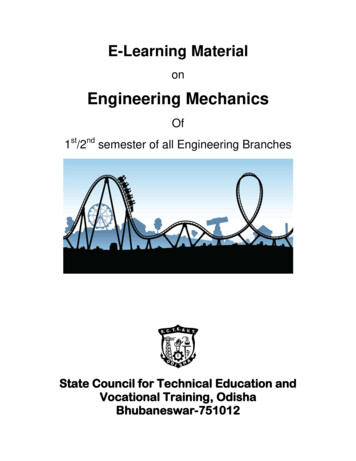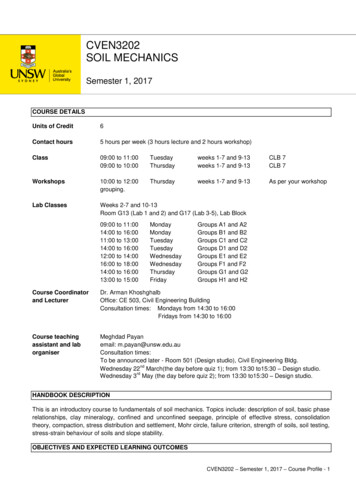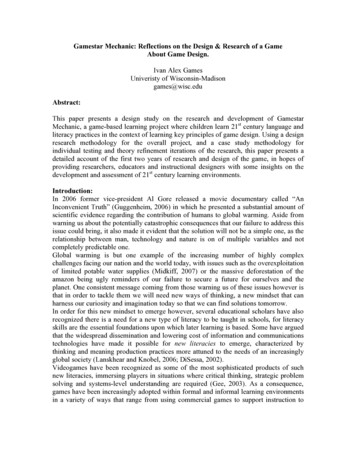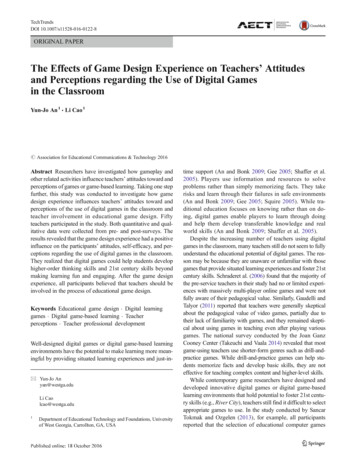
Transcription
Game MechanicsAdvanced Game DesignErnest AdamsJoris Dormans
Game MechanicsAdvanced Game DesignErnest AdamsJoris Dormans
Game Mechanics: Advanced Game DesignErnest Adams and Joris DormansNew Riders Games1249 Eighth StreetBerkeley, CA 94710(510) 524-2178Fax: (510) 524-2221Find us on the Web at www.newriders.comTo report errors, please send a note to errata@peachpit.comNew Riders Games is an imprint of Peachpit, a division of Pearson EducationCopyright 2012 Ernest Adams and Joris DormansSenior Editor: Karyn JohnsonDevelopmental Editor: Robyn ThomasTechnical Editor: Tobi SaulnierCopy Editor: Kim WimpsettProduction Editor: Cory BormanComposition: WolfsonDesignProofreader: Bethany StoughIndexer: Valerie PerryInterior Design: Charlene Will, WolfsonDesignCover Design: Peachpit Press/Charlene WillNotice of RightsAll rights reserved. No part of this book may be reproduced or transmitted in any form byany means, electronic, mechanical, photocopying, recording, or otherwise, without the priorwritten permission of the publisher. For information on getting permission for reprints andexcerpts, contact permissions@peachpit.com. See the next page for image credits.Notice of LiabilityThe information in this book is distributed on an “As Is” basis, without warranty. While everyprecaution has been taken in the preparation of the book, neither the authors nor Peachpitshall have any liability to any person or entity with respect to any loss or damage caused oralleged to be caused directly or indirectly by the instructions contained in this book or by thecomputer software and hardware products described in it.TrademarksMany of the designations used by manufacturers and sellers to distinguish their products areclaimed as trademarks. Where those designations appear in this book, and Peachpit was awareof a trademark claim, the designations appear as requested by the owner of the trademark. Allother product names and services identified throughout this book are used in editorial fashiononly and for the benefit of such companies with no intention of infringement of the trademark. No such use, or the use of any trade name, is intended to convey endorsement or otheraffiliation with this book.ISBN-13: 978-0-321-82027-3ISBN-10: 978-0-321-82027-49 8 7 6 5 4 3 2 1Printed and bound in the United States of America
Respectfully dedicated to the memory of Mabel Addis Mergardt,principal designer of The Sumerian Game (later made famousas HAMURABI), the first game with an internal economy thatI ever played.— Ernest W. AdamsTo Marije van Dodeweerd for love.— Joris Dormans
ivGame Mechanics: Advanced Game DesignAcknowledgmentsThe genesis of this book was a late-night meeting between the two of us during theG-Ameland student game jam festival on a small island off the north coast of theNetherlands. Joris Dormans showed the Machinations framework to Ernest Adams,and Ernest Adams promptly said, “We should write a book about game mechanics.”But it took nearly two years and the advice and assistance of many other peoplebefore we were done. Now it is time to thank them.Our deepest appreciation goes to Mary Ellen Foley and Marije van Dodeweerd, ourbeloved mates, who patiently tolerated very late nights, missed holidays and weekends, and the occasional rant about the vagaries of the writing process. We’ll makeit up to you if we can!Stéphane Bura suggested that Joris should create an interactive tool when he saw theoriginal, static version of the Machinations diagrams.Jesper Juul made the invaluable distinction between games of emergence and gamesof progression that informs the entire book.Remko Scha had a big impact on the formal scrutiny of the Machinations framework in his capacity as Joris Dormans’s PhD supervisor.Mary Ellen Foley kindly checked and corrected all our references.The colleagues and students at the Amsterdam University of Applied Sciences alwayshave been willing test subjects for much of the material that ended up in this book.We must also thank a number of people for permission to reproduce images:Alexandre Duret-Lutz, for his photo of The Settlers of Catan; Andrew Holmes, forhis photo of Kriegsspiel; Jason Lander, for his photo of Power Grid; Johan BichelLindegaard, for his photo of Johan Sebastian Joust; Wikimedia Commons contributorpopperipopp, for his or her photo of the game Connect Four. We are also gratefulto the Giant Bomb website (www.giantbomb.com), for permission to reproduce screenshots from their collection.Thanks to Mika Palmu, Philippe Elsass, and all other contributors to FlashDevelop,for creating the open source development tool that was used to program theMachinations Tool.We are extremely grateful to the many anonymous people who have helped to buildInkscape, the open source Scalable Vector Graphics editor, without which it wouldhave been much more difficult to produce our illustrations.
vAs Elrond said, the last place is the place of honor. We thank Margot Hutchison,Ernest Adams’s agent, for assistance with the contract. Tobi Saulnier was our wiseand sharp-eyed technical editor. Her suggestions are present but invisible throughout the book, and we’re deeply grateful that the CEO of a game company would bewilling to take the time to help us. Robyn G. Thomas, our tireless (and seeminglysleepless) development editor, pleaded, cajoled, threatened, and oversaw the wholeprocess with her usual flair and attention to detail. And finally, special thanks toKaryn Johnson, senior editor at Peachpit Press, for having the faith in us to let uswrite the book in the first place.We hasten to add that the blame for any errors or omissions belongs entirely to usand not to any of the foregoing.We welcome all comments, questions, and criticism; please write to Joris Dormansat jd@jorisdormans.nl and to Ernest W. Adams at ewadams@designersnotebook.com.About the AuthorsJoris Dormans (PhD) is a Dutch lecturer, researcher, and gameplay engineer basedin Amsterdam, the Netherlands, working in industry and higher education since2005. For the past four years, he has been researching formal tools and methods todesign game mechanics. His other area of research focuses on how to leverage formal design methods to generate games procedurally. Dr. Dormans has presentedpapers and hosted workshops on game design on many academic and industryconferences. As an independent freelance game designer, he published and workedon several video and board games. Among these are story-driven adventure games,physical platform games, and a satirical political card game. He has also participatedin all Global Game Jams to date. His professional website is at www.jorisdormans.nl. Ernest W. Adams is an American game design consultant and teacher residing inEngland. In addition to his consulting work, he gives game design workshops andis a popular speaker at conferences and on college campuses. Mr. Adams has workedin the interactive entertainment industry since 1989 and founded the InternationalGame Developers’ Association in 1994. He was most recently employed as a leaddesigner at Bullfrog Productions, and for several years before that, he was the audio/video producer on the Madden NFL line of football games at Electronic Arts. In hisearly career, he was a software engineer, and he has developed online, computer,and console games for machines from the IBM 360 mainframe to the present day.Mr. Adams is the author of four other books, including Fundamentals of Game Design,the companion volume to this book. He also writes the Designer’s Notebook seriesof columns on the Gamasutra game developers’ webzine. His professional website isat www.designersnotebook.com.
viGame Mechanics: Advanced Game DesignAbout the Technical EditorTobi Saulnier is founder and CEO of 1st Playable Productions, a game developmentstudio that specializes in design and development of games tailored to specificaudiences. Games developed by 1st Playable span numerous genres to appeal toplay styles and preferences of each group and include games for young children,girls, middle schoolers, young adults, and some that appeal to broad audiences.The studio also creates games for education. Before joining the game industry in2000, Tobi managed R&D in embedded and distributed systems at General ElectricResearch and Development, where she also led initiatives in new product development, software quality, business strategy, and outsourcing. She earned her BS, MS,and PhD in Electrical Engineering from Rensselaer Polytechnic Institute.
ContentsIntroduction. xiWho Is This Book For?. . . . . . . . . . . . . . . . . . . . . . . . . . . . . . . . . . . . . . . . . . . . . . . . xiiHow Is This Book Organized? . . . . . . . . . . . . . . . . . . . . . . . . . . . . . . . . . . . . . . . . . . xiiCompanion Website. . . . . . . . . . . . . . . . . . . . . . . . . . . . . . . . . . . . . . . . . . . . . . . . . xiiichapter 1Designing Game Mechanics.1Rules Define Games . . . . . . . . . . . . . . . . . . . . . . . . . . . . . . . . . . . . . . . . . . . . . . . . . . . 1Discrete Mechanics vs. Continuous Mechanics . . . . . . . . . . . . . . . . . . . . . . . . . . . . . 9Mechanics and the Game Design Process. . . . . . . . . . . . . . . . . . . . . . . . . . . . . . . . . 12Prototyping Techniques. . . . . . . . . . . . . . . . . . . . . . . . . . . . . . . . . . . . . . . . . . . . . . . 15Summary. . . . . . . . . . . . . . . . . . . . . . . . . . . . . . . . . . . . . . . . . . . . . . . . . . . . . . . . . . . 21Exercises. . . . . . . . . . . . . . . . . . . . . . . . . . . . . . . . . . . . . . . . . . . . . . . . . . . . . . . . . . . 22chapter 2Emergence and Progression. 23The History of Emergence and Progression. . . . . . . . . . . . . . . . . . . . . . . . . . . . . . . . 23Comparing Emergence and Progression . . . . . . . . . . . . . . . . . . . . . . . . . . . . . . . . . . 24Games of Emergence . . . . . . . . . . . . . . . . . . . . . . . . . . . . . . . . . . . . . . . . . . . . . . . . . 26Games of Progression. . . . . . . . . . . . . . . . . . . . . . . . . . . . . . . . . . . . . . . . . . . . . . . . . 30Structural Differences. . . . . . . . . . . . . . . . . . . . . . . . . . . . . . . . . . . . . . . . . . . . . . . . . 37Emergence and Progression Integration . . . . . . . . . . . . . . . . . . . . . . . . . . . . . . . . . . 39Summary. . . . . . . . . . . . . . . . . . . . . . . . . . . . . . . . . . . . . . . . . . . . . . . . . . . . . . . . . . . 41ContentsExercise. . . . . . . . . . . . . . . . . . . . . . . . . . . . . . . . . . . . . . . . . . . . . . . . . . . . . . . . . . . . 42chapter 3Complex Systems and the Structureof Emergence. 43Gameplay as an Emergent Property of Games . . . . . . . . . . . . . . . . . . . . . . . . . . . . . 43Structural Qualities of Complex Systems . . . . . . . . . . . . . . . . . . . . . . . . . . . . . . . . . 47Harnessing Emergence in Games. . . . . . . . . . . . . . . . . . . . . . . . . . . . . . . . . . . . . . . . 57Summary. . . . . . . . . . . . . . . . . . . . . . . . . . . . . . . . . . . . . . . . . . . . . . . . . . . . . . . . . . . 58Exercises. . . . . . . . . . . . . . . . . . . . . . . . . . . . . . . . . . . . . . . . . . . . . . . . . . . . . . . . . . . 58vii
viiiGame Mechanics: Advanced Game Designchapter 4Internal Economy.59Elements of Internal Economies . . . . . . . . . . . . . . . . . . . . . . . . . . . . . . . . . . . . . . . . 59Economic Structure . . . . . . . . . . . . . . . . . . . . . . . . . . . . . . . . . . . . . . . . . . . . . . . . . . 62Uses for Internal Economies in Games . . . . . . . . . . . . . . . . . . . . . . . . . . . . . . . . . . . 71Summary. . . . . . . . . . . . . . . . . . . . . . . . . . . . . . . . . . . . . . . . . . . . . . . . . . . . . . . . . . . 78Exercises. . . . . . . . . . . . . . . . . . . . . . . . . . . . . . . . . . . . . . . . . . . . . . . . . . . . . . . . . . . 78chapter 5Machinations. 79The Machinations Framework. . . . . . . . . . . . . . . . . . . . . . . . . . . . . . . . . . . . . . . . . . 79Machinations Diagram Basic Elements. . . . . . . . . . . . . . . . . . . . . . . . . . . . . . . . . . . 82Advanced Node Types . . . . . . . . . . . . . . . . . . . . . . . . . . . . . . . . . . . . . . . . . . . . . . . . 93Modeling Pac-Man . . . . . . . . . . . . . . . . . . . . . . . . . . . . . . . . . . . . . . . . . . . . . . . . . . . 98Summary. . . . . . . . . . . . . . . . . . . . . . . . . . . . . . . . . . . . . . . . . . . . . . . . . . . . . . . . . . 104Exercises. . . . . . . . . . . . . . . . . . . . . . . . . . . . . . . . . . . . . . . . . . . . . . . . . . . . . . . . . . 104chapter 6Common Mechanisms. 107More Machinations Concepts . . . . . . . . . . . . . . . . . . . . . . . . . . . . . . . . . . . . . . . . . 107Feedback Structures in Games. . . . . . . . . . . . . . . . . . . . . . . . . . . . . . . . . . . . . . . . . 113Randomness vs. Emergence. . . . . . . . . . . . . . . . . . . . . . . . . . . . . . . . . . . . . . . . . . . 126Example Mechanics. . . . . . . . . . . . . . . . . . . . . . . . . . . . . . . . . . . . . . . . . . . . . . . . . 130Summary. . . . . . . . . . . . . . . . . . . . . . . . . . . . . . . . . . . . . . . . . . . . . . . . . . . . . . . . . . 144Exercises. . . . . . . . . . . . . . . . . . . . . . . . . . . . . . . . . . . . . . . . . . . . . . . . . . . . . . . . . . 145chapter 7Design Patterns. 147Introducing Design Patterns . . . . . . . . . . . . . . . . . . . . . . . . . . . . . . . . . . . . . . . . . . 147Machinations Design Pattern Language . . . . . . . . . . . . . . . . . . . . . . . . . . . . . . . . . 151Leveraging Patterns for Design . . . . . . . . . . . . . . . . . . . . . . . . . . . . . . . . . . . . . . . . 168Summary. . . . . . . . . . . . . . . . . . . . . . . . . . . . . . . . . . . . . . . . . . . . . . . . . . . . . . . . . . 169Exercises. . . . . . . . . . . . . . . . . . . . . . . . . . . . . . . . . . . . . . . . . . . . . . . . . . . . . . . . . . 170
ixchapter 8Simulating and Balancing Games. 171Simulated Play Tests. . . . . . . . . . . . . . . . . . . . . . . . . . . . . . . . . . . . . . . . . . . . . . . . . 171Playing with Monopoly. . . . . . . . . . . . . . . . . . . . . . . . . . . . . . . . . . . . . . . . . . . . . . . 179Balancing SimWar. . . . . . . . . . . . . . . . . . . . . . . . . . . . . . . . . . . . . . . . . . . . . . . . . . . 187From Model to Game. . . . . . . . . . . . . . . . . . . . . . . . . . . . . . . . . . . . . . . . . . . . . . . . 195Summary. . . . . . . . . . . . . . . . . . . . . . . . . . . . . . . . . . . . . . . . . . . . . . . . . . . . . . . . . . 195Exercises. . . . . . . . . . . . . . . . . . . . . . . . . . . . . . . . . . . . . . . . . . . . . . . . . . . . . . . . . . 196chapter 9Building Economies. 197Economy-Building Games. . . . . . . . . . . . . . . . . . . . . . . . . . . . . . . . . . . . . . . . . . . . 197Analyzing Caesar III. . . . . . . . . . . . . . . . . . . . . . . . . . . . . . . . . . . . . . . . . . . . . . . . . 199Designing Lunar Colony . . . . . . . . . . . . . . . . . . . . . . . . . . . . . . . . . . . . . . . . . . . . . . 206Summary. . . . . . . . . . . . . . . . . . . . . . . . . . . . . . . . . . . . . . . . . . . . . . . . . . . . . . . . . . 219Exercises. . . . . . . . . . . . . . . . . . . . . . . . . . . . . . . . . . . . . . . . . . . . . . . . . . . . . . . . . . 220chapter 10Integrating Level Design and Mechanics.221From Toys to Playgrounds . . . . . . . . . . . . . . . . . . . . . . . . . . . . . . . . . . . . . . . . . . . . 221Missions and Game Spaces. . . . . . . . . . . . . . . . . . . . . . . . . . . . . . . . . . . . . . . . . . . . 229Learning to Play. . . . . . . . . . . . . . . . . . . . . . . . . . . . . . . . . . . . . . . . . . . . . . . . . . . . 238Summary. . . . . . . . . . . . . . . . . . . . . . . . . . . . . . . . . . . . . . . . . . . . . . . . . . . . . . . . . . 244chapter 11Progression Mechanisms. 247Lock-and-Key Mechanisms . . . . . . . . . . . . . . . . . . . . . . . . . . . . . . . . . . . . . . . . . . . 247Emergent Progression. . . . . . . . . . . . . . . . . . . . . . . . . . . . . . . . . . . . . . . . . . . . . . . . 258Summary. . . . . . . . . . . . . . . . . . . . . . . . . . . . . . . . . . . . . . . . . . . . . . . . . . . . . . . . . . 270Exercises. . . . . . . . . . . . . . . . . . . . . . . . . . . . . . . . . . . . . . . . . . . . . . . . . . . . . . . . . . 270ContentsExercises. . . . . . . . . . . . . . . . . . . . . . . . . . . . . . . . . . . . . . . . . . . . . . . . . . . . . . . . . . 246
xGame Mechanics: Advanced Game Designchapter 12Meaningful Mechanics. 271Serious Games. . . . . . . . . . . . . . . . . . . . . . . . . . . . . . . . . . . . . . . . . . . . . . . . . . . . . . 271Communication Theory. . . . . . . . . . . . . . . . . . . . . . . . . . . . . . . . . . . . . . . . . . . . . . 276The Semiotics of Games and Simulations. . . . . . . . . . . . . . . . . . . . . . . . . . . . . . . . 282Multiple Layers of Meaning. . . . . . . . . . . . . . . . . . . . . . . . . . . . . . . . . . . . . . . . . . . 294Summary. . . . . . . . . . . . . . . . . . . . . . . . . . . . . . . . . . . . . . . . . . . . . . . . . . . . . . . . . . 299Exercises . . . . . . . . . . . . . . . . . . . . . . . . . . . . . . . . . . . . . . . . . . . . . . . . . . . . . . . . . . 300Appendix AMachinations Quick Reference. 301Appendix BDesign Pattern Library. 303Static Engine. . . . . . . . . . . . . . . . . . . . . . . . . . . . . . . . . . . . . . . . . . . . . . . . . . . . . . . 303Dynamic Engine. . . . . . . . . . . . . . . . . . . . . . . . . . . . . . . . . . . . . . . . . . . . . . . . . . . . 305Converter Engine. . . . . . . . . . . . . . . . . . . . . . . . . . . . . . . . . . . . . . . . . . . . . . . . . . . 308Engine Building . . . . . . . . . . . . . . . . . . . . . . . . . . . . . . . . . . . . . . . . . . . . . . . . . . . . 311Static Friction . . . . . . . . . . . . . . . . . . . . . . . . . . . . . . . . . . . . . . . . . . . . . . . . . . . . . . 314Dynamic Friction. . . . . . . . . . . . . . . . . . . . . . . . . . . . . . . . . . . . . . . . . . . . . . . . . . . 316Stopping Mechanism . . . . . . . . . . . . . . . . . . . . . . . . . . . . . . . . . . . . . . . . . . . . . . . . 319Attrition . . . . . . . . . . . . . . . . . . . . . . . . . . . . . . . . . . . . . . . . . . . . . . . . . . . . . . . . . . 321Escalating Challenge . . . . . . . . . . . . . . . . . . . . . . . . . . . . . . . . . . . . . . . . . . . . . . . . 325Escalating Complexity. . . . . . . . . . . . . . . . . . . . . . . . . . . . . . . . . . . . . . . . . . . . . . . 327Arms Race. . . . . . . . . . . . . . . . . . . . . . . . . . . . . . . . . . . . . . . . . . . . . . . . . . . . . . . . . 330Playing Style Reinforcement . . . . . . . . . . . . . . . . . . . . . . . . . . . . . . . . . . . . . . . . . . 333Multiple Feedback. . . . . . . . . . . . . . . . . . . . . . . . . . . . . . . . . . . . . . . . . . . . . . . . . . . 336Trade. . . . . . . . . . . . . . . . . . . . . . . . . . . . . . . . . . . . . . . . . . . . . . . . . . . . . . . . . . . . . 336Worker Placement. . . . . . . . . . . . . . . . . . . . . . . . . . . . . . . . . . . . . . . . . . . . . . . . . . . 336Slow Cycle. . . . . . . . . . . . . . . . . . . . . . . . . . . . . . . . . . . . . . . . . . . . . . . . . . . . . . . . . 336Appendix CGetting Started with Machinations. 337References. 338Index. 341Online Appendix B.B-1Online Appendix C. C-1
IntroductionThis is a book about games at their deepest level. No matter how good a game looks,it won’t be fun if its mechanics are boring or unbalanced. Game mechanics creategameplay, and to build a great game, you must understand how this happens.Game Mechanics will show you how to design, test, and tune the core mechanics ofa game—any game, from a huge role-playing game to a casual mobile phone gameto a board game. Along the way, we’ll use many examples from real games that youmay know: Pac-Man, Monopoly, Civilization, StarCraft II, and others.This book isn’t about building Unreal mods or cloning somebody else’s app that’strending right now. It’s called Advanced Game Design for a reason. We wrote GameMechanics to teach you the timeless principles and practice of mechanics designand, above all, to give you the tools to help you do it—for a class, for a career, fora lifetime.We also provide you with two unique features that you won’t find in any othertextbook on game design. One is a new tool called Machinations that you can use tovisualize and simulate game mechanics on your own computer, without writing anycode or using a spreadsheet. Machinations allows you to actually see what’s goingon inside your mechanics as they run and to collect statistical data. Not sure if yourinternal economy is balanced correctly? Machinations will let you perform 1,000runs in a few seconds to see what happens and put all the data at your fingertips.Machinations was created by Joris Dormans and is easy to use on any computerthat has Adobe Flash Player installed in its web browser. You don’t have to use theMachinations Tool to benefit from the book, though. It’s simply there to help reinforce the concepts.IntroductionThe other unique feature of Game Mechanics is our design pattern library. Other authorshave tried to document game design patterns before, but ours is the first to distillmechanics design to its essence: the deep structures of game economies that generate challenge and the many kinds of feedback loops. We have assembled a collectionof classic patterns in various categories: engines of growth, friction, and escalation,plus additional mechanisms that create stability cycles, arms races, trading systems,and many more. We’ve made these general enough that you can apply them toany game you build, yet they’re practical enough that you can load them in theMachinations Tool and see how they work.Game mechanics lie at the heart of all game design. They implement the livingworld of the game; they generate active challenges for players to solve in the gameworld, and they determine the effects of the players’ actions on that world. It is thegame designer’s job to craft mechanics that generate challenging, enjoyable, andwell-balanced gameplay.We wrote this book to help you do that.xi
xiiGame Mechanics: Advanced Game DesignWho Is This Book For?Game Mechanics is aimed at game design students and industry professionalswho want to improve their understanding of how to design, build, and test themechanics of a game. Although we have tried to be as clear as we can, it is notan introductory work. Our book expands on the ideas in another book by ErnestAdams called Fundamentals of Game Design (New Riders). We refer to it from timeto time, and if you lack a grounding in the basics of game design, you might find ithelpful to read the current edition of Fundamentals of Game Design first.The chapters in Game Mechanics end with exercises that let you practice the principles we teach. Unlike the exercises in Fundamentals of Game Design, many of themrequire a computer to complete.How Is This Book Organized?Game Mechanics is divided into 12 chapters and 2 appendixes that contain valuablereference information. There is also a quick reference guide to Machinations inAppendix A.Chapter 1, “Designing Game Mechanics,” establishes key ideas and defines termsthat we use in the book, and it discusses when and how to go about designing gamemechanics. It also lists several forms of prototyping.Chapter 2, “Emergence and Progression,” introduces and contrasts the importantconcepts of emergence and progression.Chapter 3, “Complex Systems and the Structure of Emergence,” describes the natureof complexity and explains how complexity creates emergent, unpredictable gamesystems.Chapter 4, “Internal Economy,” offers an overview of internal economies. We showhow the structure of an economy creates a game shape and produces different phasesof gameplay.Chapter 5, “Machinations,” introduces the Machinations visual design language andthe Machinations Tool for building and simulating mechanics. It includes an extensive example using Pac-Man as a model.Chapter 6, “Common Mechanisms,” describes a few of the more advanced featuresof Machinations and shows how to use it to build and simulate a wide variety ofcommon mechanisms, with examples from many popular game genres.Chapter 7, “Design Patterns,” provides an overview of the design patterns in ourdesign pattern library and offers suggestions about how to use them to brainstormnew ideas for your designs.
xiiiChapter 8, “Simulating and Balancing Games,” explains how to use Machinationsto simulate and balance games, with case studies from Monopoly and Will Wright’sSimWar.Chapter 9, “Building Economies,” explores economy-building games, using CaesarIII as an example, and takes you through the design and refinement process for anew game of our own, Lunar Colony.Chapter 10, “Integrating Level Design and Mechanics,” moves into new territory,looking at how game mechanics integrate with level design and how properlysequenced challenges help the player learn to play.Chapter 11, “Progression Mechanisms,” discusses two kinds of progression. We startwith traditional lock-and-key mechanics and then consider emergent progressionsystems in which progress is treated a resource within the economy of the game.Chapter 12, “Meaningful Mechanics,” concludes the book with an exploration of therole of mechanics in transmitting meaning in games that have a real-world messageto send. This topic is increasingly important now that game developers are makingmore serious games: games for health care, education, charity, and other purposes.Appendix A, “Machinations Quick Reference,” lists the most commonly usedelements of the Machinations Tool.Appendix B, “Design Pattern Library,” contains several patterns from our designpattern library. You can find the completed design pattern library in the onlineAppendix B at www.peachpit.com/gamemechanics and a much more extensive discussion of each design pattern in Chapter 7.Companion WebsiteAt www.peachpit.com/gamemechanics you’ll find material for instructors, digital copiesof many of the Machinations diagrams used in this book, more design patterns,and a step-by-step tutorial to get you started with Machinations. To get access tothis bonus material, all you need to do is register yourself as a Peachpit reader. Thematerial on the website may be updated from time to time, so make sure you havethe latest versions.IntroductionAppendix C, “Getting Started with Machinations,” is available online atwww.peachpit.com/gamemechanics and provides a tutorial for using theMachinations Tool.
This page intentionally left blank
chapter 4Internal EconomyIn real life, an economy is a system in which resources are produced, consumed, andexchanged in quantifiable amounts. Many games also include an economy, consisting of the resources the game manipulates and the rules about how they areproduced and consumed. However, in games, the internal economy can include allsorts of resources that are not part of a real-life economy. In games, things like health,experience, and skill can be part of the economy just as easily as money, goods, andservices. You might not have money in Doom, but you do have weapons, ammunition,health, and armor points. In the board game Risk, your armies are a vital resource thatyou must use and risk in a gambit to conquer countries. In Mario Galaxy, you collectstars and power-ups to gain extra lives and to get ahead in the game. Almost all genresof games have an internal economy (see Table 1.1 in Chapter 1 for some more examples), even if it does not resemble a real-world economy.To understand a game’s gameplay, it is essential to understand its economy. Theeconomies of some games are small and simple, but no matter how big or smallthe economy is, c
Game Mechanics Advanced Game Design Ernest Adams Joris Dormans Crawford chris c rawford on interactive storytelling ISBN-13: ISBN-10: 978--321-82027-3 -321-82027-4 9 780321 820273 57499 Ernest Adams is a game design consultant, teacher, and the author of the classic

